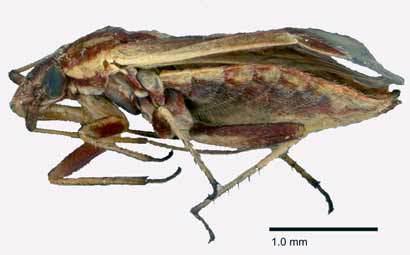

This is Restiophylus lyginiae, one of four new species of plant bugs found in Australia.
Credit: Entomological Society of America
A new genus of plant bug and four new species have been discovered in Australia. The newly discovered insects, which belong to the family Miridae and the subfamily Phylinae, are described in the Annals of the Entomological Society of America.
Stephanie Leon and Christiane Weirauch, two entomologists from the University of California, Riverside, examined 761 specimens from museum collections and determined that some were mislabeled and were actually species that were not yet known to science.
The new genus is called Restiophylus. “Restio” comes from the host-plant association of most of its members with the plant family Restionaceae, and “phylus” indicates that it is classified in the subfamily Phylinae.
The four new species are R. hypolaenae, R. leptocarpi, R. lyginiae, and R. meeboldinae. R. hypolaenae is named for its association with plants in the genus Hypolaena. R. leptocarpi is named for its association with plants in the genus Leptocarpus. R. lyginiae is named for its association with plants in the genus Lyginia, and R. meeboldinae is named for its association with plants in the subgenus Meeboldina of the genus Leptocarpus.
Restiophylus species are currently the only arthropods that are documented to be closely associated with Australian restiid clade (Poales).
Habitus images, illustrations of male genitalia, scanning micrographs, an identification key, and distribution maps for the new species are provided in the article, as well as digital images and distribution maps for the hosts.
###
The full article, “Restiid-Feeding Semiini (Hemiptera: Miridae: Phylinae) From Western Australia: Description and Phylogenetic Analysis of the New Plant Bug Genus Restiophylus, n. gen,” is available at http://dx.
Annals of the ESA is published by the Entomological Society of America, the largest organization in the world serving the professional and scientific needs of entomologists and people in related disciplines. Founded in 1889, ESA today has nearly 7,000 members affiliated with educational institutions, health agencies, private industry, and government. Members are researchers, teachers, extension service personnel, administrators, marketing representatives, research technicians, consultants, students, and hobbyists. For more information, visit http://www.












